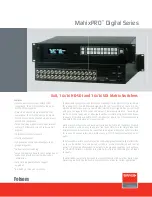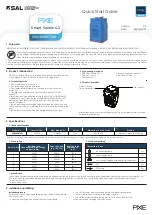
ProSwitch Quad-Series Fiber Switches
Installation and User Guide
Page 18
The ProSwitch Quad-Series switches operate in the store-and-forward switching mode, which
eliminates bad packets and enables peak performance to be achieved when there is heavy traffic on the
network.
Address Learning
All
16-port
ProSwitch Quad-Series units have address table capacity of 24K node addresses
(12K for 8-port models), suitable for use in large networks. They are self-learning, so that as nodes are
added or removed or moved from one segment to another, the Quad-Port Switch automatically keeps up
with node locations.
An address-aging algorithm causes least-used addresses to fall out in favor of new frequently
used addresses. To reset the address buffer, cycle power down-and-up.
4.2 Status
LEDs
For all ProSwitch Quad-Series models :
PWR:
Power LED, ON when external power is applied to the unit.
LK:
Steady ON, Link status for 10Mbps and 100Mbps operation.
ACT:
ON with port activity for 10Mbps and 100Mbps operation.
F/H:
Full / Half duplex LED, ON when the port is running full duplex, OFF for half duplex.
100/10:
Speed LED, ON when the speed is 100Mbps, OFF when the speed is 10Mbps
4.3
Manual Switches for
Up-link push-button, for RJ45 quad-port only
Figure 4.3 : Up-link push-button on RJ45 quad-port
The module has a manual Up-link push-button, located on the front panel next to 10/100Mbps
RJ45 Quad-port # 1 which it controls. It enables the port’s cable to either connect to a user station node
(push in) or to be cascaded (push out) to a 10/100Mbps repeater or switching hub in the network. Verify
proper Up-link push-button position by noting Port 1’s LK (link) LED status, which is illuminated when a
proper link is made.
4.4
Auto-negotiation, for Fast Ethernet copper ports
The ProSwitch Quad-Series Fast Ethernet copper ports can be set for either fixed 100Mbps
speed or for 10/100 F/H N-way auto-negotiation per the IEEE802.3u standard. The selection is made via
an internal jumper (see Section 3.4 for jumper-setting instructions). The factory default setting is for auto-
negotiation. At 100Mbps-fixed speed, the user may select half- or full-duplex mode by internal jumpers
for each RJ45 port separately.
One frequently used application for the ProSwitch Quad-Switch copper ports is to connect one of
them using a fiber media converter to another Switch in the network backbone, or to some other remote
100Mbps device. In this case, it is desirable to operate the fiber link at 100Mbps speed, and at either
half- or full duplex mode depending on the capabilities of the remote device. Standard commercially
available Fast Ethernet media converters mostly do not support auto-negotiation properly, and require
that the switched port to which they are connected be at 100Mbps fixed speed. Attachment to 10/100
auto-negotiation ports typically will not work properly. The Quad-Switch’s RJ45 ports handle this situation
by changing the internal jumper settings. (see Section 3.4)
100/10
FDX/HDX
LK
x
ACT
1 2 3 4
ProSwitch Quad-Series Fiber Switches
Installation and User Guide
Page 19
When Quad-Switch’s RJ45 copper ports are set for auto-negotiation and connected to another
auto-negotiating device, there are 4 different speed and F/H modes selection depending on what the
other device supports. These are: (1) 100Mbps full duplex, (2) 100Mbps half-duplex, (3) 10Mbps full
duplex and (4) 10Mbps half-duplex.
The auto-negotiation logic will attempt to operate in descending order and will normally arrive at
the highest order mode that both devices can support at that time. (Since auto-negotiation is potentially
an externally controlled process, the original “highest order mode” result can change at any time
depending on network changes that may occur). If the device at the other end is not an auto-negotiating
device, the Quad-Switch’s RJ45 ports will try to detect its idle signal to determine 10 or 100Mbps speed,
and will default to half-duplex at that speed per the IEEE standard.
General information -
Auto-negotiation per-port for 802.3u-compliant switches occurs when:
•
the devices at both ends of the cable are capable of operation at either 10Mbps or 100Mbps
speed and/or in full- or half-duplex mode, and can send/receive auto-negotiation pulses, and .
.
•
when the second of the two connected devices is powered up*, i.e., when LINK is established
for a port, or
•
when LINK is re-established on a port after being lost temporarily.
NOTE
–
some NIC cards only auto-negotiate when the computer system that they are in is
powered up. These are exceptions to the “negotiate at LINK – enabled” rule above, but may be
occasionally encountered.
When operating in 100Mbps half-duplex mode, cable distances and hop-counts may be limited
within that collision domain. The Path Delay Value (PDV) bit-times must account for all devices and cable
lengths within that domain. For ProSwitch Quad-Series Fast Ethernet switched ports operating at
100Mbps half-duplex, the bit time delay is 50BT.
4.5
Auto-negotiation for 10Mbps ports, half- or full-duplex mode
Full-duplex Ethernet provides separate Transmit and Receive data paths, enabling simultaneous
bi-directional collision-free data movements on a port. The network topology must be a “star” type, not a
“bus” type. With full-duplex mode, the cable distance is only limited by the physical layer line driver and
cable attenuation. There are no collision-domain restrictions or limitations.
The ProSwitch Quad-Series switches perform half- or full duplex mode auto-negotiation
independently on all switched ports. If the device or node on the other end of a port’s attached cable
supports F/H mode auto-negotiation or is set to operate as full duplex, the ProSwitch Quad-Port Switch
will negotiate to run full-duplex. If the attached device or node doesn’t support F/H mode auto-negotiation
(for example, if it is a 10Mbps repeater or a standard 10Mbps hub), the Quad-Switch’s RJ45 ports will
default to operate at half-duplex.
4.6
Flow-control, IEEE 802.3x standard
ProSwitch Q- Series switches incorporate a flow-control mechanism for Full-Duplex mode. The
purpose of flow-control is to reduce the risk of data loss if a long burst of activity causes the switch to
save frames until its buffer memory is full. This is most likely to occur when data is moving from a
100Mbps port to a 10Mbps port, and the speed difference makes the 10Mb port unable to keep up. It can
also occur when multiple 100Mbps ports are attempting to transmit to one 100Mbps port, and in other
protracted heavy traffic situations.
ProSwitch Q-Series fiber switches implement the 802.3x flow control (non-blocking) on full duplex
ports, which provides for a “PAUSE” packet to be transmitted to the sender when the packet buffer is
nearly filled and there is danger of lost packets. The transmitting device is commanded to stop
transmitting into the Quad-switch port for sufficient time to let the switch reduce the buffer space used.
When the available free-buffer queue increases, the switch will send a “RESUME" packet to indicate the
































